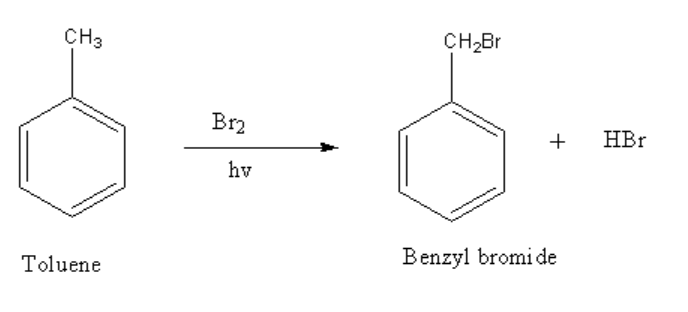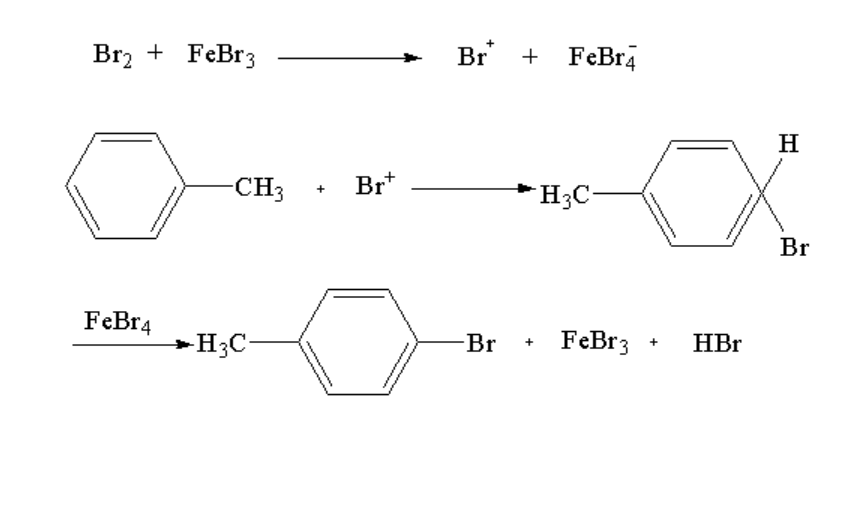
Toluene reacts with bromine in the presence of light to give benzoyl bromide, while in the presence of \[FeB{r_3}\], it gives p-bromotoluene. Give an explanation for the above observations.
Answer
221.4k+ views
Hint: The reaction of toluene with bromine in presence of light is an example of a free radical mechanism. Free radicals are electronic species which contain unpaired electrons in their atomic orbital.
Complete Step by Step Solution:
The reaction between toluene and bromine in the presence of light is shown below.

Image: Reaction of toluene with bromine
In the above reaction, toluene reacts with bromine in the presence of light to form benzyl bromide. In the presence of light, the side chain bromination reaction takes place due to the formation of free radicals.
The reaction between toluene and iron (III) bromide is shown below.

Image: Reaction of toluene with iron(III) bromide
When toluene reacts with iron (III) bromide, the benzene undergoes electrophilic substitution which leads to formation of the main product p-bromo toluene as the methyl group is o- and p- directing.
An electrophilic substitution reaction is a type of chemical reaction where a functional group attached to a compound is displaced by an electrophile group. The functional group which is displaced is mainly hydrogen atoms.
The electrophilic substitution reactions involve three steps:
1. In the first step, an electrophile is generated.
2. In the second step, carbocation is formed which acts as an intermediate.
3. In the third step removal of a proton from the intermediate takes place.
Note: In the electrophilic substitution reaction of toluene and iron (III) oxide, iron (III) bromide acts as a lewis acid. Lewis acids are the species that accept lone pairs of electrons.
Complete Step by Step Solution:
The reaction between toluene and bromine in the presence of light is shown below.

Image: Reaction of toluene with bromine
In the above reaction, toluene reacts with bromine in the presence of light to form benzyl bromide. In the presence of light, the side chain bromination reaction takes place due to the formation of free radicals.
The reaction between toluene and iron (III) bromide is shown below.

Image: Reaction of toluene with iron(III) bromide
When toluene reacts with iron (III) bromide, the benzene undergoes electrophilic substitution which leads to formation of the main product p-bromo toluene as the methyl group is o- and p- directing.
An electrophilic substitution reaction is a type of chemical reaction where a functional group attached to a compound is displaced by an electrophile group. The functional group which is displaced is mainly hydrogen atoms.
The electrophilic substitution reactions involve three steps:
1. In the first step, an electrophile is generated.
2. In the second step, carbocation is formed which acts as an intermediate.
3. In the third step removal of a proton from the intermediate takes place.
Note: In the electrophilic substitution reaction of toluene and iron (III) oxide, iron (III) bromide acts as a lewis acid. Lewis acids are the species that accept lone pairs of electrons.
Recently Updated Pages
The hybridization and shape of NH2 ion are a sp2 and class 11 chemistry JEE_Main

What is the pH of 001 M solution of HCl a 1 b 10 c class 11 chemistry JEE_Main

Aromatization of nhexane gives A Benzene B Toluene class 11 chemistry JEE_Main

Show how you will synthesise i 1Phenylethanol from class 11 chemistry JEE_Main

The enolic form of acetone contains a 10sigma bonds class 11 chemistry JEE_Main

Which of the following Compounds does not exhibit tautomerism class 11 chemistry JEE_Main

Trending doubts
JEE Main 2026: Application Form Open, Exam Dates, Syllabus, Eligibility & Question Papers

Derivation of Equation of Trajectory Explained for Students

Hybridisation in Chemistry – Concept, Types & Applications

Understanding the Angle of Deviation in a Prism

How to Convert a Galvanometer into an Ammeter or Voltmeter

Degree of Dissociation: Meaning, Formula, Calculation & Uses

Other Pages
NCERT Solutions For Class 11 Chemistry Chapter 7 Redox Reaction

JEE Advanced Marks vs Ranks 2025: Understanding Category-wise Qualifying Marks and Previous Year Cut-offs

Hydrocarbons Class 11 Chemistry Chapter 9 CBSE Notes - 2025-26

Thermodynamics Class 11 Chemistry Chapter 5 CBSE Notes - 2025-26

NCERT Solutions ForClass 11 Chemistry Chapter Chapter 5 Thermodynamics

Equilibrium Class 11 Chemistry Chapter 6 CBSE Notes - 2025-26




